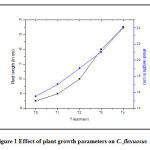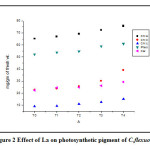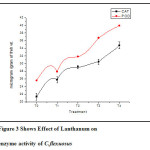Effect and Accumulation of Lanthanum on the Growth and Physiological Activities of Cymbopogon Flexuosus (Nees Ex Steud.)W.Watson
Aradhana Basu1 , Swati Sucharita Panda1 * and Nabin Kumar Dhal1
1
Environment and Sustainability Department,
CSIR-Institute of Minerals and Materials Technology,
Bhubaneswar,
751013
Odisha
India
DOI: http://dx.doi.org/10.12944/CWE.10.3.26
The rare earth elements are a set of seventeen chemical elements which involve the lanthanide series from Lanthanum (La), Tolutetium (Lu), Scandium (Sc), and Yttrium (Y) in the periodic table. Even if Rare Earth Elements are used widely in industry and agriculture in China as well as India for a long time, there has been increasing interest in the application of REEs to plants in recent years. In this paper, we discussed the effect of REE on growth and physiological activities of the plant. By compilation and investigation of these data, we found that REEs have promoting impact at certain concentration. An increase in Chlorophyll, enzymes and protein content further indicated the stimulating effect of La on physiological activities of the selected plants. Depending on the results of this preliminary investigation we can say that a new REE hyperaccumulator, Cymbopogon flexuosus (Lemon grass), was discovered which could accumulate Lanthanum is 20.725 mg g-1 and 25.625 mg g-1 dry mass in root and shoot part respectively under natural growth conditions. Advanced research should be invested regarding the impacts of REEs on yields of cultivated plants.
Copy the following to cite this article:
Basu A, Panda S. S, Dhal N. K. Effect and Accumulation of Lanthanum on the Growth and Physiological Activities of Cymbopogon Flexuosus (Nees Ex Steud.)W.Watson. Curr World Environ 2015;10(3) DOI:http://dx.doi.org/10.12944/CWE.10.3.26
Copy the following to cite this URL:
Basu A, Panda S. S, Dhal N. K. Effect and Accumulation of Lanthanum on the Growth and Physiological Activities of Cymbopogon Flexuosus (Nees Ex Steud.)W.Watson. Available from: http://www.cwejournal.org/?p=13071
Download article (pdf) Citation Manager Publish History
Select type of program for download
| Endnote EndNote format (Mac & Win) | |
| Reference Manager Ris format (Win only) | |
| Procite Ris format (Win only) | |
| Medlars Format | |
| RefWorks Format RefWorks format (Mac & Win) | |
| BibTex Format BibTex format (Mac & Win) |
Article Publishing History
| Received: | 2015-09-04 |
|---|---|
| Accepted: | 2015-11-13 |
Introduction
Rare earth elements are series of seventeen chemical elements which include the lanthanide series from Lanthanum (La), Scanadium (Sc), Tolutetium (Lu), and Yttrium (Y) in the periodic table.1 They are known as ‘‘rare earth elements’’ because most of them were isolated as oxide from rare minerals in the 18th and 19th century.2 The entire world stores an estimated 100 million metric tons of rare earth oxide (REO) and the regions having important ore reserves are China followed by Common wealth of independent states, United States, India, Canada and South Africa.3 Therefore China owns the largest rare earth deposit (Baiyun Obo rare earth ore, Baotou, Inner Mongolia), and is a major exporter of REEs,4 with more than 40% of total REEs reserves in the world. REEs are utilized extensively in industry, such as used for glass polishing and ceramics, in lighter flints, in rechargeable batteries, iron and steel additives, cell phones and as car catalytic converters as well.5 They have also been typically applied in agriculture for more than 30 years, and the resulted environmental contamination and accumulation in the food chain would grow rapidly in the next few decades.6 Metal-hyperaccumulators are the plants that can hyperaccumulate metals from its natural habitat. Phytoremediation, a technique using plant hyperaccumulator to remove contamination from soil and water, is a well and decent choice as it is safe and cost-effective. Although the hyperaccumulators of other heavy metals were studied7 less attention was paid to REE-hyperaccumulator. REEs are very likely to exist in particular forms in plants and play important role in regular physiological activities. However, there always have been controversial opinions on whether REE can enter into plant cells and influence their physiological activities. Some beneficial effects of REEs have been reported: REEs can promote the germination of seed, stimulate the growth of roots, increase the content of chlorophyll, and enhance the resistance of crops. Therefore, commercial REEs micro-fertilizer has been used widely in agriculture. The extensive utilization of Rare earth elements in industries and agriculture has become a crucial environmental problem in China. Results from field trials, laboratory studies and pot trials, the effects of Rare Earth Elements on crop growth are inconsistent.8, 9
Materials and Method
Experimental Design
To test the growth and phytoremediation potential of Cymbopogon flexuosus, an open pot trial was arranged on Lanthanum (La). The experiment was conducted in the Medicinal Plants Garden of the CSIR–Institute of Minerals and Materials Technology (IMMT), Bhubaneswar, Odisha, India, (from October 2014 to April 2015). Beneficiated Lanthanum (purity > 99%) were collected from IRE, Udyogamandal Ernakulam, Kerala and mixed in different proportions with the garden soil. The mixed samples were designated as T0—(T=garden soil) as control, T1—La: soil (1:3), T2—La: soil (1:1), T3— La: soil (3:1) and T4—only La. The samples were equilibrated completely for a month followed by the plantation of Cymbopogon flexuosus L. (15 cm long) seedlings collected from the local nursery at the rate of one seedling per earthen pot.
Physico-chemical analysis of soil and Lanthanum
Five grams of soil and Lanthanum samples with different proportion were collected from the rhizosphere zone of the plants dissolved in 50 ml of double distilled water and stirred using a magnetic stirrer for 30 min. After filtering the supernatant in the previous step, the filtrate obtained was used for measuring pH and electrical conductivity (EC) using the pH and EC meter (The HANNA instruments). Organic carbon (OC) content was determined by rapid dichromate oxidation technique10; Carbon Exchange Capacity by 1(N) ammonium acetate extraction method.11 WHC of samples was calculated using the standard protocol.12
Plant growth analysis
Plant growth was evaluated on the basis of various parameters like length, fresh and dry weight of shoot and root at monthly interval. The chlorophyll (Chl a, Chl b, Chl c, pheophytin, carotenoid) content was quantified spectrophotometrically following the protocol of Porra et al.13 The effect of Lanthanum (La) and its various treatments on activity of different antioxidant enzymes like catalase (CAT) and peroxidase (POD) were measured at monthly intervals for 4 months. The activities of Catalase and Peroxidase were analysed following the procedure of Misra and Fridovich14 Chance and Maehly,15 respectively. The activity of these enzymes was expressed as specific activity (U−1 mg protein). The protein content of plant sample was quantified spectrophotometrically following the method of Lowry16
Lanthanum (REE) analysis of plant tissue
Plant samples were divided into shoot and root and then carefully rinsed with tap water followed by Milli-Q water, dried under 105 0C for 24 hours. The dried tissues were ground to powder. Finally, the plant samples were digested in aquaregia (HNO3/HCl, 1:3), and thereby, concentration of Lanthanum was determined using the PerkinElmer Optima 2100 DV, ICP-OES (Inductively coupled plasma-Optical emission spectroscopy) after adjustment for required dilution factor. All the reagents and reference standards were of analytical grade from Merks (Darmstadt, Germany). Suprapure hydrochloric and nitric acids (Merks, Darmstadt, Germany) were used for sample digestion and preparation of standards. Translocation factor was further determined using the following formula.17
Translocation factor (TF) was calculated using the following formula:

C shoots- concentration of metal in shoot
C roots – concentration of metal in root
Statistical Analysis
The data were statistically analyzed with the help of computer software SPSS (version13.00). The data shown are the averages of three replicates ± SD with statistically significant value.
Result and Discussion
Physico Chemical Analysis of Soil and Lanthanum
The physico-chemical properties of soil, Lanthanum, and its mixture samples are presented in Table 1. Lanthanum is comparatively acidic in nature as compared to garden soil. The pH range varied from 6.9 to 7.1.Electrical conductivity is a measure of soluble salt content and is used as an overall indicator of macro and micronutrients. It was also observed that electrical conductivity values for all the treatments decreased with increasing pH values. WHC is higher in garden soil as compare to Lanthanum. The soil and lanthanum samples showed large differences between their nitrogen, phosphorus and potassium content, there is no nitrogen, phosphorus and potassium present in the chromium tailing sample but in garden soil 1.5% nitrogen, 1% phosphorus, and 1.2% potassium are present.
Table 1: Showing the various physico-chemical characteristics of soil and tailing samples in various treatment samples
|
Treatment |
pH |
EC (μS/cm) |
OC (%) |
CEC c mol (+) kg−1 |
WHC (%) |
|
T0 |
7.09±0.24 |
19±0.20 |
0.5±0.29 |
11.45±0.22 |
38.7±0.03 |
|
T1 |
7.01±0.31 |
82±0.29 |
0.45±0.23 |
10.11±0.27 |
33.4±0.05 |
|
T2 |
6.97±0.29 |
91±0.27 |
0.37±0.25 |
9.32±0.23 |
29.8±0.03 |
|
T3 |
6.8±0.30 |
143±0.28 |
0.21±0.28 |
8.21±0.25 |
25.9±0.01 |
|
T4 |
6.94±0.28 |
266±0.25 |
0.1±0.30 |
7.5±0.31 |
22.7±0.07 |
Plant Growth Parameters
The effect of Lanthanum and its varying proportion on morphological parameters of Cymbopogon flexuosus was shown in Figure 1. A continuous increase in fresh and dry weight of all the selected plants indicates stimulating effect of Lanthanum on root and shoots biomass of Lemon grass. According to Tucher and Schmidhalte18 and Chaturvedi et.al,19 a positive effect of La was observed on shoot development of spinach and Z.mays. Zhang and Zhang20 also observed significant increase in growth of corn seedlings, thus improving yield.
 |
|
Photosynthetic pigment determination
A significant increase in the concentration of photosynthetic pigments of C. flexuosus was observed with increase in the concentration of La in the treatments as shown in fig2. The chlorophyll content of leaf samples was measured at monthly intervals for 4 months. Accelerated photosynthetic activity was observed in tobacco seedlings after the treatment with 5 - 20 mg/l of lanthanum in the form of chloride salts.21 But according to some researchers, at concentrations of more than 15 mg/kg lanthanum, a decrease in chlorophyll contents was observed.22 The increased concentration of photosynthetic pigment is due the fact that, REEs increase the activities of photosystem-II in plant. It has also been reported that La accelerated the photosynthetic reactions at suitable concentration in vivo.23 Spraying rare earth on pepper improved the chlorophyll content.24
 |
|
Antioxidant Enzyme Assay
The effect of Lanthanum on the activities of various antioxidant enzymes is presented in Fig 3. Significant increase in the activities of POD and CAT was observed in the treatments than control. Peroxidase and CAT are potential scavengers of H2O2 which minimize the oxidative and other stress in plant.25 Among H2O2 destroying enzymes, the increase in CAT activity was lower than those of POD which might be due to the fact that CAT is present only in the peroxisome and has low substrate affinities.26
 |
|
Protein Analysis
In the present study, the effect of Lanthanum on the activities of protein was significantly increased in the treatments than control. The result indicated that T0 has 189.9 µg mg-1, T1 has 190.1 µg mg-1, T3 has 191.5 µg mg-1 and T4 has 192.7 µg mg-1 of protein content.
Lanthanum (REE) Analysis of Plant Tissue
The total amount of Lanthanum accumulated in root is 20.725 mg g-1 and in shoot it is 25.625 mg g-1 by ICP-OES analysis. According to Zeng et al., Pronephrium simplex accumulates up to 1.2 mg g-1 dry mass of REEs under natural growth conditions.27 The translocation factor of lemon grass was is greater than 1, implying that the shoots are a primary target of metals accumulation than root.
Conclusion
Present investigations affirm that the Lanthanum accumulated 25.625 mg g-1 and 20.725 mg g-1 in shoot and root of Cymbopogon flexuosus. REEs have significant positive effects on seed germination, growth, total biomass, production of secondary metabolite and absorption of minerals and metals for plants. But there is no clear evidence that REEs are necessary for plants to grow, many studies have suggested that REEs can stimulate plants to absorb, transfer and assimilate nutrients. Furthermore, the worldwide use of La and other REE as fertilizers as well as feed additive supports the idea of using plants to extract and remediate REE. Therefore, remediation and extraction of rare earths using suitable plants can might be of interest as effective, ecofriendly, safe and inexpensive alternative.
Acknowledgement
The authors are thankful to Prof. B.K Mishra, Director, Institute of Minerals and Materials Technology, Bhubaneswar for providing necessary facilities to carry out the work and Council of Scientific and Industrial Research, New Delhi for financial support.
Reference
- Zhou, J., Guo, L.P., Ji Z., Zhou, S.F., Yang, G., Zhao, M.X. Effects of LaCl3 on photo Synthesis and the accumulation of tanshinones and salvianolicacidsin Salvia miltiorrhiza seedlings. J Rare Earth, 29: 494–8 (2011)
- Nicodemus, M.A., Salifu, K.F., Jacobs, D.F. Influence of lanthanum level and interactions with nitrogen source on early development of Juglans nigra. J Rare Earth, 27: 270–9 (2009)
- EI-Ramady, H.R. A contribution on the bio-actions of rare earth elements in the soil/plant environment [Dissertation]. Berlin: ausdem Julius Ku¨ hn-Institut;(2008)
- Ma, C.M. Rare earth:important strategic reserve resources. Geogr Teach, 21:7. (2010)
- Kingsnorth, D.J. Rare earths at the crossroads- Dudley J King- snorth looks at the world market and sees how the industry is copying with present and future demands. Ind Miner, 492: 66–71(2008). [SeptemberIssue].
- Volokh, A.A., Gorbunov, A.V., Gundorina, S.F., Revich, B.A., Frontasyeva, M.V., Pal, C.S. Phosphorus fertilizer production as a source of rare-earth elements pollution of the environment. Science of the Total Environment, 95: 141–148. (1990)
- Salt, D.E., Smith, R.D., Raskin, I. Phytoremediation. Annu Rev Plant Phys Plant Molec Biol, 49: 643–668 (1998)
- Van steveninck, R. F. M., Van steveninck, M. E., Chescoe D. Intracellular binding of lanthanum in root tips of barley (Hordeum vulgare). Protoplasma, 90: 89-97 (1976)
- Parker, K.C.H., Hanson, R., & Hunsley, J. MMPI, Rorschach, and WAIS: A meta analytic comparison of reliability, stability, and validty. Psychological Bulletin, 103: 367-373 (1988).
- Walkey, A., Black, IA. An examination of the Degtjareff method for determining soil organic matter and a proposed modification of the chromic acid titration method. Soil Sci, 37: 29–38 (1934)
- Jackson, M.L. Soil chemical analysis, New Delhi, Prentice Hall Pvt. Ltd (1973)
- Chaturvedi, N., Dhal, N.K., Reddy, P.S.R. Phytostabilization of iron ore tailings through Calophyllum inophyllum L. Int J Phytoremediat, 14(10): 996–1009 (2012)
- Porra, R.J., Thompson, W.A., Kriedmann, P.E. Determination of accurate extinction coefficients and simultaneous equations for assaying chlorophylls a and b extracted with four different solvents: verification of the concentration of chlorophyll standards by atomic absorption spectroscopy. Biochim Biophys Acta, 975: 384–394 (1989)
- Misra, H.P., Fridovich, I. The generation of superoxide radical during auto oxidation. J Biol Chem, 247: 6960–6966 (1972)
- Chance, B., Maehly, A.C. Assay of catalase and peroxidase. Methods Enzymo, 2: 764–775 (1955)
- Lowry, O.H., Rosebraugh, N.J., Furr, A.L., Randall, R.J. Protein measurement with folin phenol reagent. Biological chemistry, 19(3): 265-266 (1951)
- ŽaltauskaitÄ—, J., ŠliumpaitÄ—, I. Evaluation of Toxic Effects and Bioaccumulation of Cadmiumand Copper in Spring Barley (Hordeum vulgare L.). Environmental Research, Engineering and Management, 2(64): 51-58 (2013)
- Tucher, S.V., Schmidhalter, U. Lanthanum uptake from soil and nutrient solution and its effects on plant growth. Journal of plant nutrition and soil science, 168: 574–580 (2005)
- Chaturvedi, N., Gannavarapu, R., Dhal, N.K. Effect of Lanthanum on the growth and physiological activities of Zea mays, Vigna radiata and Vigna mungo. Int j of env sc. 4: 653-59 (2014)
- Zhang, S., Zhang, H., Qin, R., JiangW, Liu D. Cadmium induction of lipid per oxidation and effects on root tip cells and antioxidant enzyme activities in Vicia faba L. Ecotoxicol, 18: 814–823 (2009)
- Chen, W.J., Tao, Y., Gu, Y.H., Zhao G.W. Effect of lanthanide chloride on photosynthesis and dry matter accumulation in tobacco seedlings. Biological trace element research, 79(2): 169 – 176 (2001)
- Zeng, Q., Zhu, J., Xie, Z., Chu, H., Cao, Z. Does response of rape to La and critical concentration of La in red earth. Huan Jing Ke Xue, 22(4): 77 – 80 (2001)
- Hong, F.H., Wei, Z.G., Zhao, G.W. Effect of lanthanum on aged seed germination of rice. Biological trace element research, 75: 205 –213 (2000)
- He, Y.Z., Wang, J.F., Fang, N.H., Gan, W.E., Zhao, G.W. Effects of rare earth micro-fertilizer on plant physiological indexes and yield of hot pepper. Chinese Rare Earth,19(2): 36-40 (1998)
- Pandey, V., Dixit, V., Shyam, R. Antioxidative responses in relation to growth of mustard (Brassica juncea cv. Pusa Jaikisan) plants exposed to hexavalent chromium. Chemosphere, 61: 40–47 (2005)
- Willekens, H.D., Inzé M,VanMontaguM, Van CampW. Catalase in plants. Mol Breeding, 1: 207 (1995)
- Lai Y, Wang Q*, Yan W, Yang L and Huang B. Preliminary study of the enrichment and fractionation of REEs in a newly discovered REE hyperaccumulator Pronephrium simplex by SEC-ICP-MS and MALDI-TOF/ESI-MS. J of Analytical Atomic Spectro, 20: 751-753 (2005)







